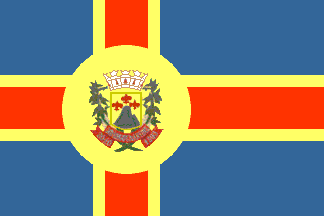 image by Blas Delgado Ortiz
image by Blas Delgado Ortiz
Last modified: 2012-02-11 by ian macdonald
Keywords: espirito santo | domingos martins |
Links: FOTW homepage |
search |
disclaimer and copyright |
write us |
mirrors
At
http://www.espiritosanto.tur.br/mun_domingos_simbolos.htm is the flag of Domingos Martins, with the
coat of arms on the same page. An off-centered cross of red, finbriated yellow,
on blue, with coat of arms at the intersection of the arms.
Dov Gutterman, 2 June 2001
The municipality of Domingos Martins (31,824 inhabitants in 2010; 1,231 sq.
km) is located in southeastern Espírito Santo, 45 km from Vitória. The
municipality is made of the town of Domingos Martins proper and of the rural
districts of Aracê (formerly known as São Rafael and Pedreiras, renamed by
State Decree No. 15,177 of 31 December 1943), Biriricas, Melgaço, Paraju
(formerly known as Sapucaia, renamed by the same Decree) and Isabel (formerly
known as Santa Isabel, renamed by the same Decree). The districts of Marechal
Floriano and Araguia seceded from Domingos Martins on 31 November 1991 (State
Law No. 4,571) to form the new municipality of Marechal Floriano.
Domingos Martins originated in Santa Isabel, a German colony founded on 27
January 1847 by Luiz Pedreira do Couto Ferraz, President of the Espírito
Santo Province. The colonists - 16 Lutheran and 23 Roman Catholic families -
all came from the Hunsrück area (Prussia). Named for the patron saint of
Crown Princess Isabel, the colony was visited on 30 January 1860 by Emperor
or Brazil Peter II. A district of the municipality of Viana since 1878, Santa
Isabel was made an independent municipality by State Decree No. 29 of 20
October 1893 and inaugurated on 19 December in Campinho, the seat of the new
municipality. To escape malaria, the municipal seat was transferred to Santa
Isabel on 26 June 1896 by Municipal Decree No. 19. In the next years, the
municipality would be known as Campinho de Santa Isabel. Campinho was
reestablished as the municipal seat by State Law No. 1,126 of 3 December
1917. The municipality was renamed Domingo Martins by State Law No. 1,307 of
30 December 1921 to honor the local hero Domingo Martins (1781-1817). The
leader of the Pernambuco Revolution, Martins was executed on 12 June 1817 in
Bahia, his last words being "I die for freedom" - he died without achieving
saying "freedom". By State Law No. 3,219 of 21 June 1978, whose Bill was
tabled by Juarez Matins Leite, the State Government is symbolically
transferred every 12 June to Domingos Martins.
The symbols of Domingos
Martins were designed by Pr. Arcinóe Antônio Peixoto de Faria.
The
cross flag symbolizes the Christian faith of the inhabitants of Domingo
Martins. The municipal coat of arms placed in the middle of the cross
represents the municipal government; the yellow disk surrounding the arms
represents the seat of the municipality. The arms of the cross represent the
spread of the municipal power over the whole municipal territory. The four
blue rectangles formed by the cross represent the rural estates. [If I am
not mistaking, these explanations are the generic rationale behind several
municipal flags designed by Arcinóe Antônio Peixoto de Faria.]
The
coat of arms uses classical elements such as a Flemish-Iberic shield, three
fleurs-de-lis and a towered mural crown. In the shield, the Pedra Azul*
represents tourism. The shield is surrounded by branches of bean and grapevine
representing the sources of income for the municipality. The red scroll is
charged with the municipality' name and foundation date.
http://www.domingosmartins.es.gov.br - Municipal website
* The Pedra
Azul (lit., Blue Stone) is a rock formation made of granite and gneiss, peaking
at 1,822 m; its surroundings form the Pedra Azul State Park (1,240 ha).
http://www.flickr.com/photos/thejourney1972/821125751 - Photo of the Pedra
Azul flag
Ivan Sache, 16 January 2012